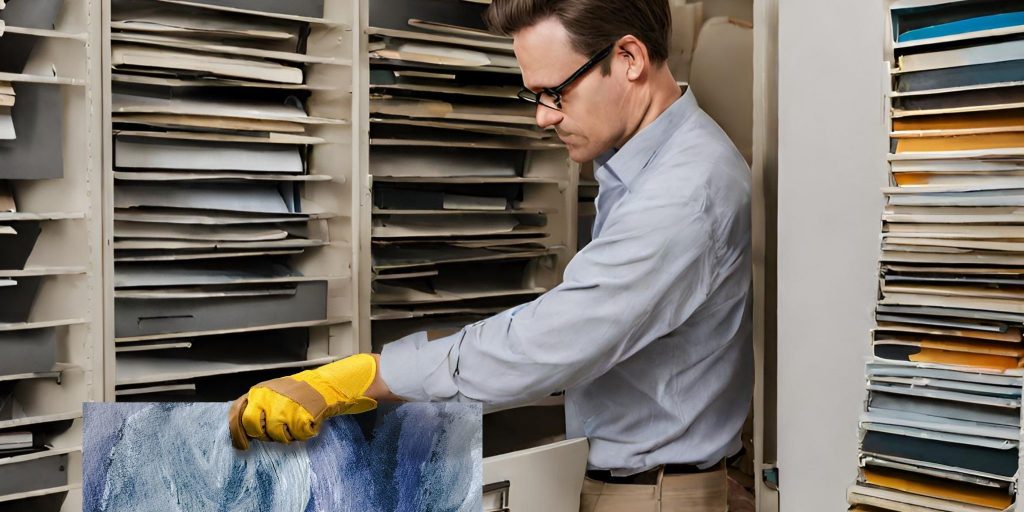
If you’re planning to store your works of art, there are several long-term storage solutions for adequate preservation. Instead of rolling up your artwork and placing it in a poster tube, valuable pieces should be kept flat. That way, you will have peace of mind. You’ll avoid causing wrinkles, folds, deterioration, and other types of damage that can occur when storing rolled-up paper long-term. Whether for long- or short-term storage space, be sure to follow these tips for properly storing your art.
Appropriate Storage
Purveyors of the fine arts know that whether it’s for seasonal items or for months of years, climate controlled storage units are key. This doesn’t mean you need to pay monthly fees for offsite storage facilities. It simply means that you should store your belongings in a room with a temperature between 65 and 72 degrees Fahrenheit.
While the room should have good air circulation and no dampness or humidity, you can’t simply store your items out in the open without proper protection. These long- and short-term storage units are used by art conservateurs:
Encapsulation: When you encapsulate a document or piece of art, the work is encased in polyester film and, when properly sealed, your document lives in a permanent microclimate. While encased, you can handle and inspect the work without causing any damage. This method is best used for previously deacidified double-sided art, so both sides can be viewed and inspected.
Matboard with a Wrapped Face Cover: Similar to encapsulation, this method is used for one-sided pieces of art and involves placing the art between a sheet of polyester film and a sheet of rag or conservation matboard. The film should be 1/2 larger than the matboard on all sides and taped to the back. Do not tightly wrap the art, as some air should be allowed to circulate through it.
Covered Window Mat: A covered window mat is recommended for use with works that need special protection while in storage like pastels, graphites, charcoals, and other fragile documents/pieces of art. The work is matted and then another sheet of matboard is placed on top and hinged on one side with pressure-sensitive linen tape. The cover mat will protect the fragile piece, yet the hinge will allow you easy access to the piece for inspection.
Solander Boxes: A solander box is a special acid-free, airtight box with hinged front panels. These boxes are ideal for storing unframed art, as the hinge allows you to easily add and remove pieces. Once closed, the box will protect the work inside. You can purchase different unit sizes of solander boxes from conservation suppliers.
Deep-Sided Storage Boxes: These storage boxes are made from acid-free or rag matboard. The board is scored, and then the sides are folded up and taped at the corners with pressure-sensitive tape. The top is made in the same way, only slightly larger. The box does not create an airtight seal like a solander box, but it will help protect the works inside from dust, heat, light, and humidity when kept in a safe environment.

Good Storage Location
Storing Unmatted, Loose Art: Ideally, loose artwork should be kept in shallow drawers and cabinets where there is little chance of scuffing and very little weight buildup. It’s recommended that similar-sized pieces be stored together, but keep acidic works, such as news clippings, separated, the acids in the paper can be transferred to other documents and cause damage. Also, always place slip sheets between your pieces for better protection.
Storing Framed Art: Framed oil paintings and documents should always be stored vertically and preferably in cabinets with extra space offered by foam or felt-covered separators. For long-term storage units, all hanging devices and wires should be removed to prevent damage to other pieces.
All artwork, framed or loose, needs to be kept in a safe environment, preferably climate-controlled and away from mold and mildew, dust, insects, air pollutants, and out of damp and/or humid areas. It’s important to periodically examine your stored artwork to be sure no damage has occurred.

Museum-Quality Frames
As a business owner with more than three decades of experience in the custom framing business, I can attest to one of the best long-term storage options: archival-quality frames. After all, it’s what art galleries use to protect Leonardo da Vinci and Picasso masterpieces.
Not just any frame will do, however. It should be handcrafted with acid-free matting, mounting, and backing boards that meet the U.S. Library of Congress’ standards for document preservation. Church Hill Classics frames also offer UV-protective glass to prevent against yellowing, fading, and cracking. It’s best to protect and preserve your artwork in a museum-quality frame built to Professional Picture Framers Association specifications.










